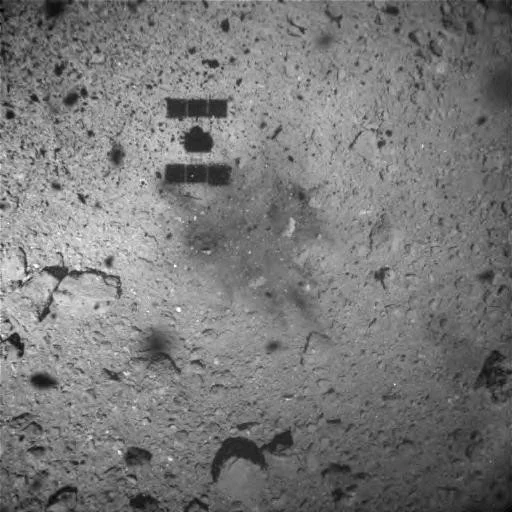NASA’s First Asteroid Sample Return Mission
Animated flyover of the near Earth asteroid Bennu’s North Pole. Taken with OCAMS instrument on NASA’s OSIRIS-REx spacecraft. Credit: NASA/Goddard/University of Arizona
On December 31, 2018 NASA’s OSIRIS-REx mission went into orbit around Near Earth Asteroid (NEA) 101955 Bennu. The OSIRIS-REx mission is NASA's first sample return mission from an asteroid. The science obtained from in-situ observations and the returned sample will advance our understanding of asteroids by an order of magnitude. Very little is currently known about NEAs, so these results will aid future exploration missions.
OSIRIS-REx launched on September 8, 2016 and spent almost two years in transit to Bennu. This mission involves two main parts. The first part is to perform in-situ observations of the asteroid's composition and formation, along with the Yarkovsky effect on Bennu. The second part is a sample return back to Earth.
The Yarkovsky effect is the small force objects in space receive due to solar heat. The force is difficult to simulate because it requires a detailed understanding of the specific object, including surface features, orbit, and rotation. Over time the Yarkovsky effect is enough to induce a minimal change in the orbit of the object. Understanding this effect is important for being able increase the accuracy of asteroid orbital propagations. This means that the predictions of future asteroid orbits can be more accurate. Knowing this will help predict asteroid-Earth collisions, and aid planning for asteroid prospecting missions.
The OSIRIS-REx spacecraft has five instruments that are currently unveiling Bennu’s secrets, including:
OCAMS - Three high-resolution visual camera to provide global imaging, along with observing the sample site and sampling event
OLA - A LIDAR unit to create high-accuracy 3D models of the asteroid surface
OTES - A thermal emission spectrometer to map temperature for determining mineral abundances
OVIRS - A visible and infrared spectrometer to identify mineral and organic material
REXIS - An X-ray imaging spectrometer to analyze chemical elements on the surface
Diagram of the OSIRIS-REx sample acquisition and stowage sequence. This will be NASA’s first sample return mission to an asteroid. Credit: NASA
An exciting part of the OSIRIS-Rex mission is that it will attempt to collect over 60 grams (2 ounces) of regolith from the surface of Bennu. This will occur after the spacecraft has had time to complete a detailed study of the asteroid. Part of this study will involve selecting the precise area to sample that is both scientifically interesting and safe to reach. While OSIRIS-REx must plan this encounter carefully, it does have sufficient resources to make three attempts if it doesn’t collect as much sample as is desired. These attempts are limited by the supply of high-pressure nitrogen carried on-board, which is essential for the sampling process.
The sample acquisition mechanism (TAGSAM) is attached to a robotic arm. The OSIRIS-REx mission is able to make three attempts at collecting samples from Bennu. The goal is to collect 150 grams of material. Credit: NASA
The OSIRIS-REx mission plans to use a Touch And Go Sample Acquisition Mechanism (TAGSAM) to collect the sample. The process involves contacting the asteroid for five seconds with a sample collection head connected to the end of a two meter long robotic arm. After the contact period elapses, springs push the spacecraft away and a dedicated camera confirms the sample has been retrieved. The arm then puts the entire sample collection head into the Sample Return Capsule (SRC) which then closes for its return to Earth.
The collection process used by the regolith sample collection head involves using a jet of compressed nitrogen gas that agitates regolith beneath the head, pushing it past protective mylar flaps, and into a collector. The mylar flaps are only pushed open by the nitrogen gas. While mission goals are to collect 150 grams (5 ounces), the science goals only need 60 grams (2 ounces). However, the sample collection head is built with capability to collect a maximum of 2000 grams (70 ounces) of material. Because of a hinge on the sampling head, the surface can be contacted at an angle of up to 15 degrees. Due to the designed accuracy of the system, OSIRIS-REx should be capable of targeting a point within 25 meters of the selected location.
Diagram of the sample collection mechanism that will be used by OSIRIS-REx to collect a sample of the near Earth asteroid Bennu. Nitrogen is used to force surface regolith into the collection container. Only three attempts will be possible due to the limited supply of nitrogen. Credit: NASA/Lockheed Martin
In 2021 OSIRIS-REx will burn its main engines to place itself on a trajectory away from Bennu. With the sample of Bennu safety stored within the sample return capsule, OSIRIS-REx will intersect Earth orbit in 2023. Five hours before reaching Earth’s atmosphere, OSIRIS-REx will jettison the sample return capsule that will fall to Earth. Entering Earth’s atmosphere at 12.4 km/s (27,738 mph), the return capsule will use its PICA heat shield to survive reentry, and later land under parachute. This will be one of the fastest human-made objects to attempt an atmospheric reentry. Meanwhile, OSIRIS-REx will place itself in orbit around the Sun.
After years of preparation, development, and high risk space operations, OSIRIS-REx will be NASA's first mission to visit a near Earth asteroid and return a sample. The sample from Bennu will be heavily analyzed on Earth using instruments only available on the ground. Although OSIRIS-REx won't explore the interior of Bennu, it will help scientists understand asteroid surface properties and aid the link between asteroids and comets. The space community knows very little about asteroids, so this mission will increase our knowledge of asteroids and how their resources can be used for future missions.
RESOURCES
https://www.nasa.gov/press-release/nasa-prepares-to-launch-first-us-asteroid-sample-return-mission
https://www.asteroidmission.org
http://spaceflight101.com/osiris-rex
https://www.space.com/33776-osiris-rex.html









